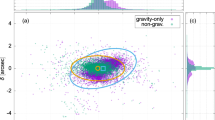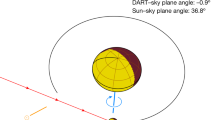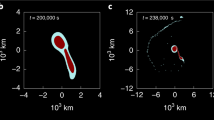Abstract
The rotation rates of asteroids, which are deduced from periodic fluctuations in their brightnesses1, are controlled by mutual collisions2–8. The link between asteroid spin and collision history is usually made with reference to impact experiments on centimetre-scale targets, where material strength governs the impact response2,3,9–11. Recent work, however, indicates that for objects of the size of most observed asteroids (≥1 km in diameter), gravity rather than intrinsic strength controls the dynamic response to collisions12–14. Here we explore this idea by modelling the effect of impacts on large gravitating bodies. We find that the fraction of a projectile's angular momentum that is retained by a target asteroid is both lower and more variable than expected from laboratory experiments, with spin evolution being dominated by 'catastrophic' collisions that eject ∼50 per cent of the target's mass. The remnant of an initially non-rotating silicate asteroid that suffers such a collision rotates at a rate of ∼2.9 per day, which is close to the observed mean asteroid rotation rate of ∼2.5 d–1. Moreover, our calculations suggest that the observed trend in the mean spin frequency for different classes of asteroids4 (2.2 d–1for C-type asteroids, 2.5 d–1 for S-type, and 4.0 d–1 for M-type) is due to increasing mean density, rather than increasing material strength.
This is a preview of subscription content, access via your institution
Access options
Subscribe to this journal
Receive 51 print issues and online access
$199.00 per year
only $3.90 per issue
Buy this article
- Purchase on Springer Link
- Instant access to full article PDF
Prices may be subject to local taxes which are calculated during checkout
Similar content being viewed by others
References
Harris, A. W. & Lupishko, D. F. in Asteroids II (eds Binzel, R. P., Gehrels, T. & Matthews, M. S.) 39–53 (Univ. Arizona Press, Tucson, 1989).
Farinella, P., Davis, D. R., Paolicchi, P., Cellino, A. & Zappalá, V. Astron. Astrophys. 253, 604–614 (1992).
Cellino, A., Zappalá, V., Davis, D. R., Farinella, P. & Paolicchi, P. Icarus 87, 391–402 (1990).
Binzel, R. P., Farinella, P., Zappalá V. & Cellino A. in Asteroids II (eds Binzel, R. P., Gehrels, T. & Matthews, M. S.) 416–441 (Univ. Arizona Press, Tucson, 1989).
Davis, D. R., Weidenschilling, S. J., Farinella, P., Paolicchi, P. & Binzel, R. P. in Asteroids II (eds Binzel, R. P., Gehrels, T. & Matthews, M. S.) 805–826 (Univ. Arizona Press, Tucson, 1989).
Dobrovolskis, A. R. & Burns, J. A. Icarus 57, 464–476 (1984).
Harris, A. W. Icarus 40, 142–153 (1979).
Burns, J. A. & Safronov, V. S. Mon. Not. R. Astron. Soc. 165, 403–411 (1973).
Fujiwara, A. et al. in Asteroids II (eds Binzel, R. P., Gehrels, T. & Matthews, M. S.) 240–265 (Univ. Arizona Press, Tucson, 1989).
Fujiwara, A. & Tsukamoto, A. Icarus 48, 329–334 (1981).
Yanagisawa, M., Eluszkiewicz, J. & Ahrens, T. J. Icarus 94, 272–282 (1991).
Holsapple, K. A. Planet:Space Sci. 42, 1067–1078 (1994).
Ryan, E. V. & Melosh, H. J. Eos 76, F336 (1995).
Love, S. G. & Ahrens, T. J. Icarus 124, 141–155 (1996).
Monaghan, J. J. Annu. Rev. Astron. Astrophys. 30, 543–574 (1992).
Harris, A. W. Lunar Planet. Sci. XXVII, 493–494 (1996).
Bottke, W. F. Jr & Melosh, H. J. Nature 381, 51–53 (1996).
Dones, L. & Tremaine, S. Science 259, 350–354 (1993).
Bottke, W. F. Jr, Nolan, M. C., Greenberg, R. & Kolvoord, R. A. Icarus 107, 255–268 (1994).
Tillotson, J. H. General Atomic Rep. GA-3216 (General Atomic div. General Dynamics corp., San Diego, California, 1962).
Melosh, J. H. Impact Cratering: A Geologic Process (Oxford Univ. Press, New York, 1989).
Belton, M. J. S. et al. Nature 374, 785–788 (1995).
Author information
Authors and Affiliations
Rights and permissions
About this article
Cite this article
Love, S., Ahrens, T. Origin of asteroid rotation rates in catastrophic impacts. Nature 386, 154–156 (1997). https://doi.org/10.1038/386154a0
Received:
Accepted:
Issue Date:
DOI: https://doi.org/10.1038/386154a0
This article is cited by
Comments
By submitting a comment you agree to abide by our Terms and Community Guidelines. If you find something abusive or that does not comply with our terms or guidelines please flag it as inappropriate.



